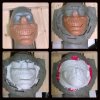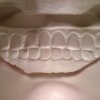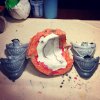There have been several Twisty the Clown builds around here, so I won't throw in a bunch of progress pictures. I just mostly wrapped up my version last night (a few symmetry issues still to fix), and have some questions on the best way to finish, and mold it.



I've never worked with Chavant before, so this is a bit new for me. I really liked working with it, but I'm not sure how to best smooth it. I've brushed over it with lighter fluid, and that got rid of most of the tooling marks, but there are still some I'd like to smooth out. But I also want to keep a few, for texture.
For molding this, I've read that platinum cure silicone doesn't always play well with chavant. Is this true? Any suggestions for what would work best for this? (I typically use Rebound)
I recently tried doing a more matrix-style mold (see Eyeless Jack thread), which didn't work out as great as I hoped, and that was an extremely simple form. I do like the idea of those though, as opposed to just brushing on, and then throwing a support shell on top.
Any tips on the best way of approaching the mold? I don't have a degasser, so am worried about all the detail, were I do to the shell first, and then fill with silicone.



I've never worked with Chavant before, so this is a bit new for me. I really liked working with it, but I'm not sure how to best smooth it. I've brushed over it with lighter fluid, and that got rid of most of the tooling marks, but there are still some I'd like to smooth out. But I also want to keep a few, for texture.
For molding this, I've read that platinum cure silicone doesn't always play well with chavant. Is this true? Any suggestions for what would work best for this? (I typically use Rebound)
I recently tried doing a more matrix-style mold (see Eyeless Jack thread), which didn't work out as great as I hoped, and that was an extremely simple form. I do like the idea of those though, as opposed to just brushing on, and then throwing a support shell on top.
Any tips on the best way of approaching the mold? I don't have a degasser, so am worried about all the detail, were I do to the shell first, and then fill with silicone.






